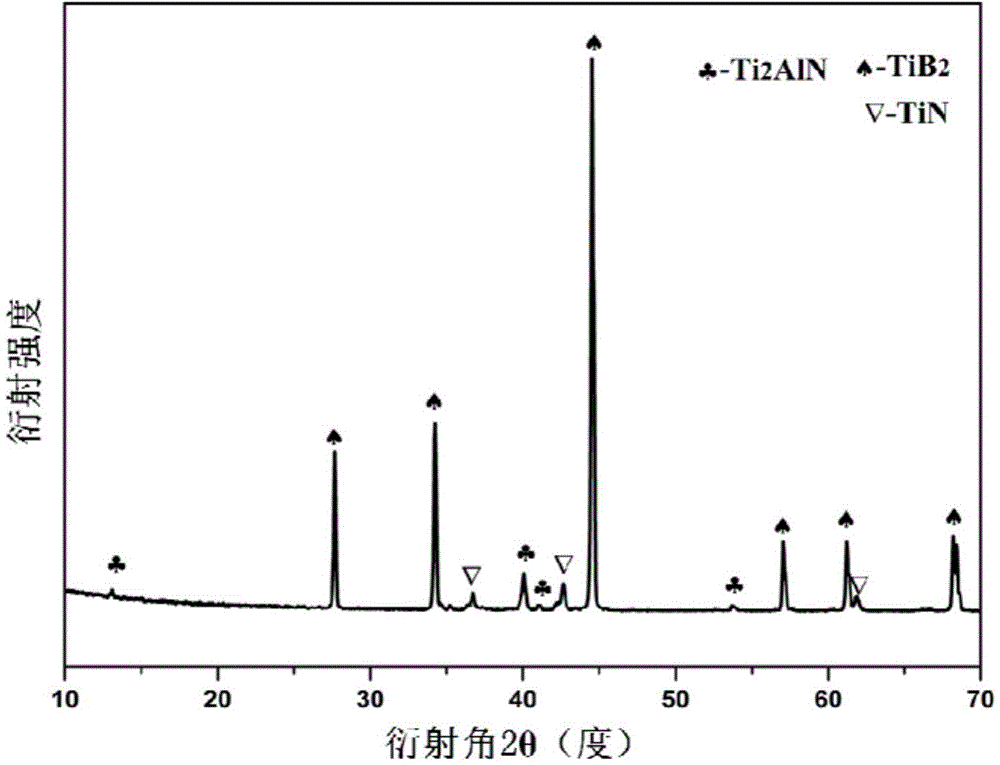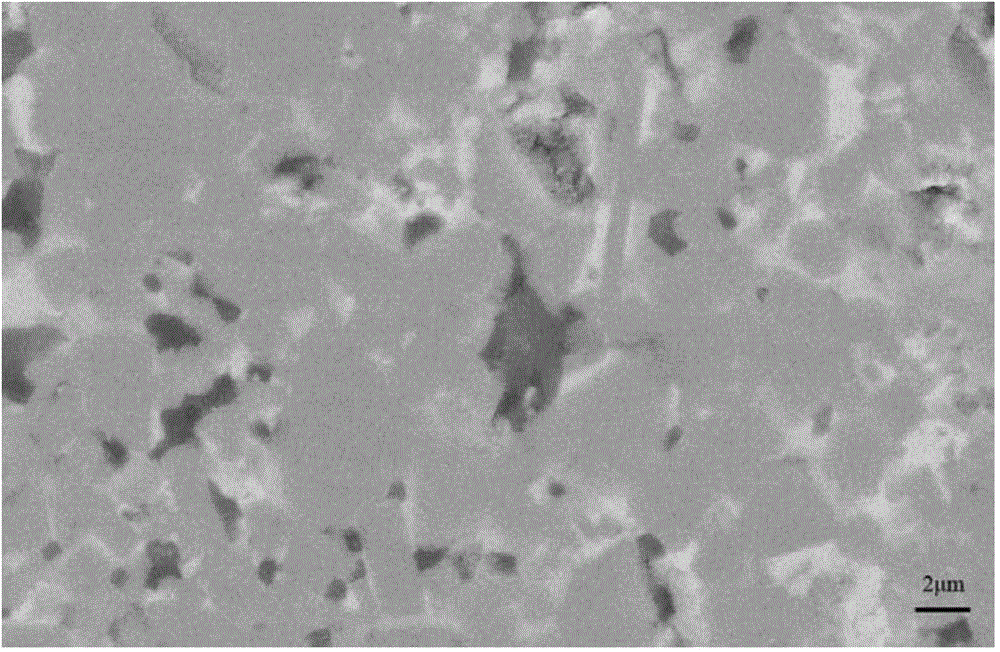Method for obtaining compact titanium diboride material by using in-situ reaction between sintering aids
A sintering aid, titanium diboride technology, which is applied in the field of structural ceramics, can solve the problems of unfavorable and impacted high temperature mechanical properties and corrosion resistance of ceramics, and achieve the effects of easy control of process conditions, simple process and excellent mechanical properties.
- Summary
- Abstract
- Description
- Claims
- Application Information
AI Technical Summary
Problems solved by technology
Method used
Image
Examples
Embodiment 1
[0031] 7.5 grams of hexagonal boron nitride powder with a particle size of 10 microns, 8.2 grams of aluminum powder with a particle size of 400 mesh and 34.3 grams of titanium powder with a particle size of 200 mesh were ball-milled in a ball mill for 8 hours, dried and sieved, and more than 1.5 grams of the The mixed powder was mixed with 28.5 grams of 800 mesh titanium diboride powder and ball milled in a ball mill jar for 8 hours, dried and sieved. Then put it into a graphite mould, and cold-press to form it. The applied pressure is 20 MPa. After cold-pressing for 10 minutes, put it into a hot-press furnace for hot-press sintering. The heating rate is 20°C / min, heated to 1550°C and kept for 2 hours, and the pressure is gradually increased to 40MPa while the temperature is rising. The whole sintering process is carried out under the protection of argon. The material in this embodiment is mainly composed of titanium diboride, a small amount of titanium nitride and aluminum o...
Embodiment 2
[0033] 6 grams of hexagonal boron nitride powder with a particle size of 5 microns, 7 grams of aluminum powder with a particle size of 300 mesh, and 38 grams of titanium powder with a particle size of 300 mesh were ball-milled in a ball mill for 16 hours, dried and sieved, and more than 10 grams of all The mixed powder is mixed with 40 grams of 5000 mesh titanium diboride powder, ball milled in a ball mill jar for 16 hours, dried and sieved. Then put it into a graphite mould, and cold-press to form it. The applied pressure is 10 MPa. After cold-pressing for 25 minutes, put it into a hot-press furnace for hot-press sintering. The heating rate is 10°C / min, heated to 1500°C and kept for 1 hour, and the pressure is gradually increased to 20MPa while the temperature is rising. The whole sintering process is carried out under the protection of argon. The material in this embodiment is mainly composed of titanium diboride, titanium nitride and a small amount of aluminum titanium nit...
Embodiment 3
[0036]8.5 grams of hexagonal boron nitride powder with a particle size of 0.5 microns, 6.5 grams of aluminum powder with a particle size of 200 mesh and 30 grams of titanium powder with a particle size of 400 mesh were ball milled in a ball mill for 24 hours, dried and sieved, and more than 9 grams of the The mixed powder is mixed with 21 grams of 3000 mesh titanium diboride powder, ball milled in a ball mill jar for 24 hours, dried and sieved. Then put it into a graphite mould, and form it by cold pressing, the applied pressure is 10MPa, after cold pressing for 30 minutes, put it into a discharge plasma sintering furnace for sintering. The heating rate is 100°C / min, heated to 1250°C and kept for 10 minutes, and the pressure is gradually increased to 30MPa while the temperature is rising. The whole sintering process is carried out under the protection of argon. The material in this embodiment is mainly composed of titanium diboride and a small amount of titanium nitride and a...
PUM
| Property | Measurement | Unit |
|---|---|---|
| bending strength | aaaaa | aaaaa |
| hardness | aaaaa | aaaaa |
| elastic modulus | aaaaa | aaaaa |
Abstract
Description
Claims
Application Information
 Login to View More
Login to View More - R&D
- Intellectual Property
- Life Sciences
- Materials
- Tech Scout
- Unparalleled Data Quality
- Higher Quality Content
- 60% Fewer Hallucinations
Browse by: Latest US Patents, China's latest patents, Technical Efficacy Thesaurus, Application Domain, Technology Topic, Popular Technical Reports.
© 2025 PatSnap. All rights reserved.Legal|Privacy policy|Modern Slavery Act Transparency Statement|Sitemap|About US| Contact US: help@patsnap.com



